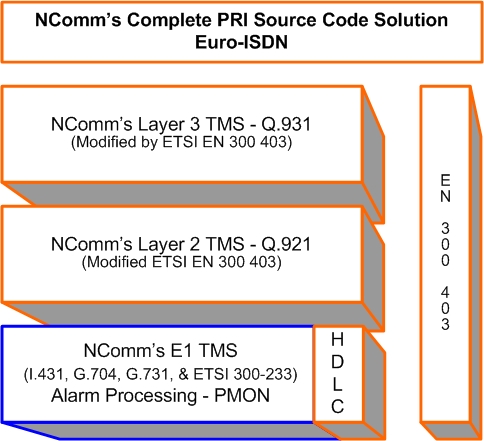The Complete Euro-ISDN Solution for PRI
 NComm’s PRI Trunk Management Software (TMS) provides a modular approach that enables the development of an international hardware platform that can be factory or real-time configured for worldwide distribution. It allows the equipment firm to take full advantage the unifying standards and the latest, most flexible hardware options available.
NComm’s PRI Trunk Management Software (TMS) provides a modular approach that enables the development of an international hardware platform that can be factory or real-time configured for worldwide distribution. It allows the equipment firm to take full advantage the unifying standards and the latest, most flexible hardware options available.
Some Background on Euro-ISDN – ETSI EN 300 403
(Q.931 & Q.921)
Euro-ISDN is a model for successful international collaboration with the benefits ultimately going to the citizens of the European Community. For decades, country specific communication products were required and were different enough that producing variants was not trivial. It is no surprise that, since a single product for the United States addressed a third of the worldwide market, there was far more attention paid to, and products available for, that single market. Since Canadian requirements were almost identical in many cases, that single product could enter a market that comprised virtually all the demand on the North American continent even with the inclusion of Mexico.
The “European” market was really many markets with significant differences between countries including hardware and software requirements, and basic technologies. And, even if a product would work in several countries, the certification (homologation) process could be anything from an annoyance to a nightmare. While there may have been some “pure” reasons for this, certifications were used by some countries as a barrier to foreign equipment manufacturers.
The real effect of this lack of common standards and protectionism was to stifle telecommunications development with the final cost going to the end users. One of the reactions of European countries was to be offended that more products weren’t targeted for their markets. But, another reaction was to recognize the economic forces at work and then work to fix them.
The European community resolved to yield their individual pursuits in favor of a unified standard for telecommunications across all member countries. Early intent to accomplish this can be seen in the Council of European Communities recommendations of 1984 and 1986, in the Council directive of 1990 and in the Council resolution of 1992. While you can glean the general philosophy of their intent, the specific focus was on ISDN as the unifying communication technology to bind the communications infrastructure and services. This commonly accepted ISDN version is referred to as Euro-ISDN.
Euro-ISDN is based on ETSI EN 300 403. It draws heavily on CCITT standards including Q.931 and Q.921 and it deals mostly with exceptions, deviations and clarifications to the referenced standards. Therefore, all relevant standards need to be acquired for a complete understanding and implementation.
Following is an excerpt from the Forward from ETSI EN 300 403-1 V1.3.2 (1999-11) European Standard (Telecommunications series) that breaks down this multi-part document:
This European Standard (Telecommunications series) has been produced by ETSI Technical Committee Services and Protocols for Advanced Networks (SPAN). The present document is part 1 of a multi-part EN covering the Integrated Services Digital Network (ISDN); Digital Subscriber Signalling System No. one (DSS1) protocol; Signalling network layer for circuit-mode basic call control, as identified below:
Part 1: "Protocol specification [ITU-T Recommendation Q.931 (1993), modified]";
Part 2: "Specification and Description Language (SDL) diagrams";
Part 3: "Protocol Implementation Conformance Statement (PICS) proforma specification";
Part 4: "Test Suite Structure and Test Purposes (TSS&TP) specification for the user";
Part 5: "Abstract Test Suite (ATS) and partial Protocol Implementation eXtra Information for Testing (PIXIT) proforma specification for the user";
Part 6: "Test Suite Structure and Test Purposes (TSS&TP) specification for the network";
Part 7: "Abstract Test Suite (ATS) and partial Protocol Implementation eXtra Information for Testing (PIXIT) proforma specification for the network".
The present document which is based upon ITU-T Recommendation Q.931 (1993) is an extended and updated version of ETS 300 403-1 (1995) and ETS 300 102-1 (1990). Annex ZA identifies relevant differences between the present document and these standards.
As touched on earlier, the primary ITU standards employed in Euro-ISDN are Q.921 for Layer 2 and Q.931 for Layer 3. Other standards are also referenced in the ETSI documents.
